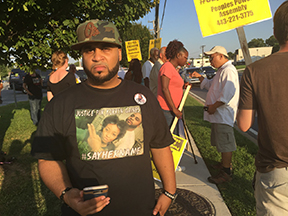With a police helicopter buzzing overhead, a small group carrying banners and placards that read “Justice for Korryn Gaines,” march in front of the Randallstown police substation. Their cause was to bring attention to what they say was the unwarranted death of a 23-year-old mother of two fatally shot by police after an hours-long barricade situation at the Carriage Hills Apartments.
Drivers honked their horns in support as the demonstrated waved and chanted “Say her name, Korryn Gaines” and shouted statements such as “Indict, convict, send those killer cops to jail. The whole damn system is guilty as hell.”
The group then marched a short distance from the Liberty Road substation to the apartment complex where Gaines lived. Officers from precinct 2 were among those who secured the perimeter. Officers went to the apartment to serve arrest warrants on Gaines and her boyfriend, Kareem Courtney, who was later charged with nine heroin-related charges.
Her cousin, Creo Brady, was among the protesters.
“I don’t believe in the justice system right now. Too many families are suffering the same fate. I am going to do what I can do to get justice,” Brady said. “The officer who shot first should be held accountable. He shot and killed my cousin and shot her son. The family is torn because of this.”
He continued, “My cousin died for what she believed. She was a loving mother, a caring cousin, she radiated love within the family whenever she could. She was loved. It’s a tragic, devastating loss.
To help the community find answers, Councilman Julian Jones is holding a community meeting about the Korryn Gaines situation on Wednesday, Sept. 22, at 6 p.m. at the Randallstown Community Center. Representatives from the Police Department and State’s Attorneys Office will be present.
Meanwhile, on Sept. 1, a month after the incident, the department has released the name of the officer who took the shots, identifying him as Officer First Class Ruby. Ruby (the officer’s last name) is a member of the tactical unit in the support operations division with 16 years of service with the department. Police fired first after they say Gaines pointed a shotgun at officers and threatened to kill them.
Standard procedure is to release the names of officers involved in police shootings about 48 hours after the incident, which according to the Fraternal Order of Police Lodge #4 agreement, is to give the officers and their family time to cope with the situation. However, Baltimore County Chief James Johnson cited the general climate around the country against law enforcement and “unprecedented” threats and security risk, which were not specified. Ruby was involved in another shooting in August 2007.
The NAACP Legal Defense and Educational Fund took issue with the police department’s changing reports about the incident, such as whether there were audio and video recordings of the interaction between Gaines and police.
The six-point letter, signed by Sherrilyn Ifill, president and director-counsel, and Monique Dixon, deputy director of policy and senior counsel, pointed out inconsistencies in the department’s statements and requested documents to back up their actions, e.g. a copy of the agreement with the Fraternal Order of Police Lodge #4, policies regarding execution of arrest warrants and identify of the hostage negotiator and crisis intervention units involved.
District 44 Senator Shirley Nathan-Pulliam said there should have been behavioral health units available to assist with negotiations. “Korryn Gaines’ life could have been saved. The situation should have been de-escalated. She had lead paint poisoning and all types of things should have come into play,” she said.
Nathan-Pulliam introduced legislation which authorizes a three-year pilot program effective Oct. 1, which requires Baltimore City and Baltimore County police departments, to the extent practicable, to establish a behavorial health unit that consists of at least six specially trained officers to respond to emergency calls involving an individual suspected of having a mental health, substance use, or co-occurring disorder.
According to the bill’s language, the goal is to divert such individuals into treatment instead of the criminal justice system and “to prevent and reduce unnecessary use of force and loss of life.”
According the police spokesperson, Elise Armacost, about 10 members of the county police department’s negotiating team worked the incident, and the team is trained extensively in de-escalation techniques, crisis intervention and basic mental health. “The team sometimes seeks guidance, from a mental health professional and they did in this case.
“While the goal is always peaceful surrender of the subject (and almost all barricades do end peacefully here), his or her use of lethal force or the threat to use lethal force escalates the situation to an imminent public safety crisis. At that point, the mental health of the subject becomes less a factor than the need to protect officers and others at risk,” Armacost said.
Attorney J. Wyndal Gordon posted a lengthy response on his Facebook page, detailing why the Gaines’ death was wrongful on multiple levels. He questioned whether there was a negotiator and mental health professional. It will be important to hear from the boyfriend, Gordan said, which he considers “an important piece of the puzzle.”
“The facts will continue to change until the facts fit squarely within the law,” said Gordon. For example, reportedly police may have considered the situation a hostage situation with Gaines holding her son hostage, until audio recordings were required during hostage situations.
Carriage Hill was criticized for giving police the key access to Gaines apartment when she did not answer the door. Facebook was also criticized for deactivating Gaines’ Facebook page at the police department’s request.

